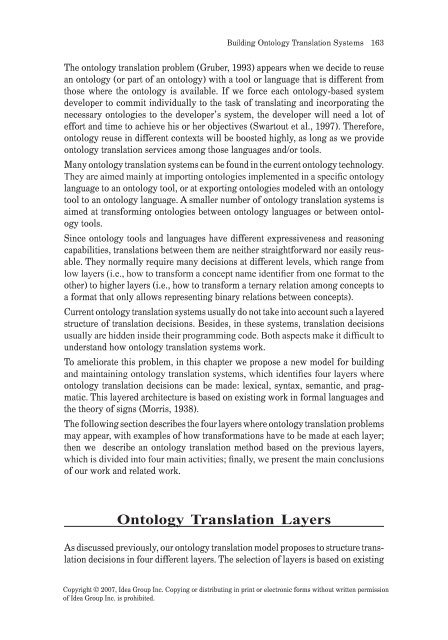Semantic Web-Based Information Systems: State-of-the-Art ...
Semantic Web-Based Information Systems: State-of-the-Art ...
Semantic Web-Based Information Systems: State-of-the-Art ...
You also want an ePaper? Increase the reach of your titles
YUMPU automatically turns print PDFs into web optimized ePapers that Google loves.
Bu ld ng Ontology Translat on <strong>Systems</strong><br />
The ontology translation problem (Gruber, 1993) appears when we decide to reuse<br />
an ontology (or part <strong>of</strong> an ontology) with a tool or language that is different from<br />
those where <strong>the</strong> ontology is available. If we force each ontology-based system<br />
developer to commit individually to <strong>the</strong> task <strong>of</strong> translating and incorporating <strong>the</strong><br />
necessary ontologies to <strong>the</strong> developer’s system, <strong>the</strong> developer will need a lot <strong>of</strong><br />
effort and time to achieve his or her objectives (Swartout et al., 1997). Therefore,<br />
ontology reuse in different contexts will be boosted highly, as long as we provide<br />
ontology translation services among those languages and/or tools.<br />
Many ontology translation systems can be found in <strong>the</strong> current ontology technology.<br />
They are aimed mainly at importing ontologies implemented in a specific ontology<br />
language to an ontology tool, or at exporting ontologies modeled with an ontology<br />
tool to an ontology language. A smaller number <strong>of</strong> ontology translation systems is<br />
aimed at transforming ontologies between ontology languages or between ontology<br />
tools.<br />
Since ontology tools and languages have different expressiveness and reasoning<br />
capabilities, translations between <strong>the</strong>m are nei<strong>the</strong>r straightforward nor easily reusable.<br />
They normally require many decisions at different levels, which range from<br />
low layers (i.e., how to transform a concept name identifier from one format to <strong>the</strong><br />
o<strong>the</strong>r) to higher layers (i.e., how to transform a ternary relation among concepts to<br />
a format that only allows representing binary relations between concepts).<br />
Current ontology translation systems usually do not take into account such a layered<br />
structure <strong>of</strong> translation decisions. Besides, in <strong>the</strong>se systems, translation decisions<br />
usually are hidden inside <strong>the</strong>ir programming code. Both aspects make it difficult to<br />
understand how ontology translation systems work.<br />
To ameliorate this problem, in this chapter we propose a new model for building<br />
and maintaining ontology translation systems, which identifies four layers where<br />
ontology translation decisions can be made: lexical, syntax, semantic, and pragmatic.<br />
This layered architecture is based on existing work in formal languages and<br />
<strong>the</strong> <strong>the</strong>ory <strong>of</strong> signs (Morris, 1938).<br />
The following section describes <strong>the</strong> four layers where ontology translation problems<br />
may appear, with examples <strong>of</strong> how transformations have to be made at each layer;<br />
<strong>the</strong>n we describe an ontology translation method based on <strong>the</strong> previous layers,<br />
which is divided into four main activities; finally, we present <strong>the</strong> main conclusions<br />
<strong>of</strong> our work and related work.<br />
Ontology.Translation.Layers<br />
As discussed previously, our ontology translation model proposes to structure translation<br />
decisions in four different layers. The selection <strong>of</strong> layers is based on existing<br />
Copyright © 2007, Idea Group Inc. Copying or distributing in print or electronic forms without written permission<br />
<strong>of</strong> Idea Group Inc. is prohibited.


